

Codex Gigas. Vulgate - Wikipedia. The Vulgate (/ˈvʌlɡeɪt, -ɡɪt/) is a late fourth-century Latin translation of the Bible that became, during the 16th century, the Catholic Church's officially promulgated Latin version of the Bible.

The translation was largely the work of St. Jerome, who, in 382 AD, was commissioned by Pope Damasus I to organize the Vetus Latina ("Old Latin") collection of biblical texts in Latin then in use by the Church. Once published, it was widely adopted and eventually eclipsed the Vetus Latina and, by the 13th century, was known as the "versio vulgata" [1] (the "version commonly-used") or, more simply, in Latin as vulgata or in Greek as βουλγάτα ("Vulgate"). Masoretic Text - Wikipedia. It was primarily copied, edited and distributed by a group of Jews known as the Masoretes between the 7th and 10th centuries of the Common Era (CE).
The oldest extant manuscripts date from around the 9th century.[3] The Aleppo Codex (once the oldest-known complete copy but now missing the Torah) dates from the 10th century. The Masoretic Text defines the Jewish canon and its precise letter-text, with its vocalization and accentuation known as the Masorah. The ancient Hebrew word mesorah (מסורה, alt. מסורת) broadly refers to the whole chain of Jewish tradition (see Oral law), which is claimed (by Orthodox Judaism) to be unchanged and infallible.
Sanskrit. Sanskrit (/ˈsænskrɪt/; संस्कृतम् saṃskṛtam [səmskr̩t̪əm], originally संस्कृता वाक् saṃskṛtā vāk, "refined speech") is the primary liturgical language of Hinduism, a philosophical language in Hinduism, Buddhism, and Jainism, and a scholarly literary language that was in use as a lingua franca in the Indian cultural zone.
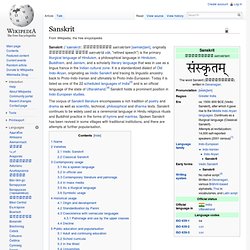
It is a standardized dialect of Old Indo-Aryan, originating as Vedic Sanskrit and tracing its linguistic ancestry back to Proto-Indo-Iranian and ultimately to Proto-Indo-European. Today it is listed as one of the 22 scheduled languages of India[3] and is an official language of the state of Uttarakhand.[4] Sanskrit holds a prominent position in Indo-European studies. The corpus of Sanskrit literature encompasses a rich tradition of poetry and drama as well as scientific, technical, philosophical and dharma texts.
Sanskrit continues to be widely used as a ceremonial language in Hindu religious rituals and Buddhist practice in the forms of hymns and mantras. Name Varieties. Quran - Wikipedia. The Quran (English pronunciation: /kɔrˈɑːn/[n 1] kor-AHN , Arabic: القرآن al-qur'ān, IPA: [qurˈʔaːn],[n 2] literally meaning "the recitation", also romanised Qur'an or Koran) is the central religious text of Islam, which Muslims believe to be a revelation from God (Arabic: الله, Allah).[1] It is widely regarded by Muslims as the finest piece of literature in the Arabic language.[2][3][4][5] Muslims consider the Quran to be the only book that has been protected by God from distortion or corruption.[6] However, some significant textual variations (employing different wordings) and deficiencies in the Arabic script mean the relationship between the text of today's Quran and an original text is unclear.[7] Quranic chapters are called suras and verses are called ayahs.
Someone who has memorized the entire Quran is called a hafiz. Some Muslims read Quranic ayahs (verses) with elocution, which is often called tajwīd. Etymology and meaning History Prophetic era. Ninety-five Theses - Wikipedia. Background[edit] Martin Luther, professor of moral theology at the University of Wittenberg and town preacher, wrote the Ninety-five Theses against the contemporary practice of the church with respect to indulgences.
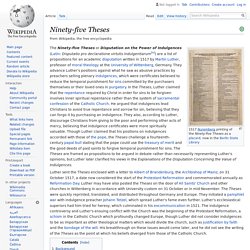
In the Catholic Church, indulgences are part of the economy of salvation. In this system, when Christians sin and confess, they are forgiven and will no longer receive eternal punishment in hell, but may still be liable to temporal punishment. This punishment could be satisfied by the penitent performing works of mercy. If the temporal punishment is not satisfied during life, it would need to be satisfied in purgatory.
Woodcut of an indulgence-seller in a church from a 1521 pamphlet Popes are empowered to grant plenary indulgences, which provide complete satisfaction for any remaining temporal punishment due to sins, and these were purchased on behalf of people believed to be in purgatory. Nicene Creed - Wikipedia. Statement of belief adopted at the First Ecumenical Council in 325 The Nicene Creed (Greek: Σύμβολον τῆς Νικαίας or, τῆς πίστεως, Latin: Symbolum Nicaenum) is a statement of belief widely used in Christian liturgy.
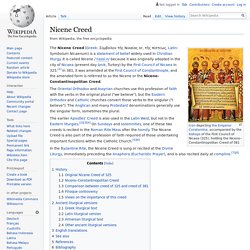
Codex Sinaiticus. Codex Sinaiticus (Modern Greek: Σιναϊτικός Κώδικας, Hebrew: קודקס סינאיטיקוס; Shelfmarks and references: London, Brit.
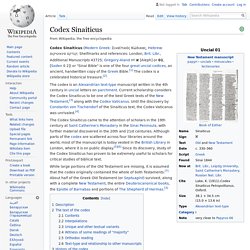
Book of Documents - Wikipedia. The Book of Documents (Shujing, earlier Shu-king) or Classic of History, also known as the Shangshu, is one of the Five Classics of ancient Chinese literature.
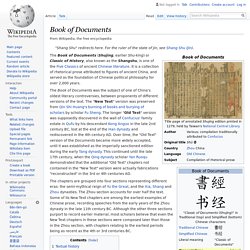
It is a collection of rhetorical prose attributed to figures of ancient China, and served as the foundation of Chinese political philosophy for over 2,000 years. Apologetics - Wikipedia. This article is about the systematic defense of a religious position.
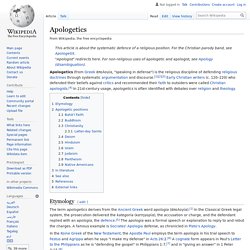
For the Christian parody band, see ApologetiX. Apologetics (from Greek ἀπολογία, "speaking in defense") is the theological science or religious discipline of defending or proving the truth of religious doctrines through systematic argumentation and discourse.[1][2][3] Early Christian writers (c. 120–220) who defended their beliefs against critics and recommended their faith to outsiders were called Christian apologists.[4] In 21st century usage, 'apologetics' is often identified with debates over religion and theology.
It may be less frequently heard in the UK[citation needed] (although the related word 'apologist' is used in a non-religious sense). Etymology[edit] Apologetic positions[edit] Bahá'í[edit] Yoga Sutras of Patanjali - Wikipedia. The Yoga Sūtras of Patañjali are 196 Indian sūtras (aphorisms) that constitute the foundational text of Ashtanga Yoga, also called Raja Yoga.
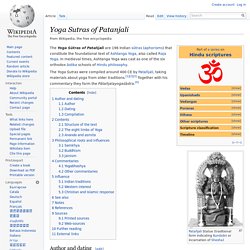
In medieval times, Ashtanga Yoga was cast as one of the six orthodox āstika schools of Hindu philosophy. The Yoga Sutras were compiled around 400 CE by Patañjali, taking materials about yoga from older traditions. Together with his commentary they form the Pātañjalayogaśāstra. Author and dating[edit] Author[edit] Akhenaten - Wikipedia. 18th dynasty pharaoh Akhenaten (;[1] also spelled Echnaton,[7] Akhenaton,[8]Ikhnaton,[9] and Khuenaten;[10][11] meaning "Effective for Aten"), known before the fifth year of his reign as Amenhotep IV (sometimes given its Greek form, Amenophis IV, and meaning "Amun Is Satisfied"), was an ancient Egyptian pharaoh of the 18th Dynasty who ruled for 17 years and died perhaps in 1336 BC or 1334 BC.
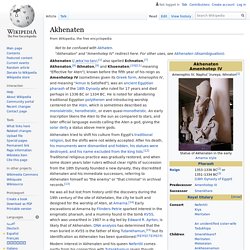
He is noted for abandoning traditional Egyptian polytheism and introducing worship centered on the Aten, which is sometimes described as monolatristic, henotheistic, or even quasi-monotheistic. An early inscription likens the Aten to the sun as compared to stars, and later official language avoids calling the Aten a god, giving the solar deity a status above mere gods. Akhenaten tried to shift his culture from Egypt's traditional religion, but the shifts were not widely accepted. Early reign as Amenhotep IV[edit] The future Akhenaten was a younger son of Amenhotep III and Chief Queen Tiye.
Hebrew Bible. 11th-century manuscript of the Hebrew Bible with Aramaic Targum The Hebrew Bible (also Hebrew Scriptures, Jewish Bible (Judaica Bible); Latin: Biblia Hebraica) is a term used by biblical scholars to refer to the Tanakh (Hebrew: תנ"ך), the canonical collection of Jewish texts, which is the common textual source of the several canonical editions of the Christian Old Testament. These texts are composed mainly in Biblical Hebrew, with some passages in Biblical Aramaic (in the books of Daniel, Ezra and a few others). The content, to which the Protestant Old Testament closely corresponds, does not act as source to the deuterocanonical portions of the Roman Catholic, nor to the Anagignoskomena portions of the Eastern Orthodox Old Testaments.
The term does not comment upon the naming, numbering or ordering of books, which varies with later Christian biblical canons. Gnostic.Org: The Kybalion. Table of ContentsIntroduction by The Three Initiates 1. Hermetic Philosophy: The lips of wisdom are closed, except to... 2. Seven Hermetic Principles: ..s/he who knows these.. 3. Mental Transmutation: Mind ... may be transmuted 4. Epic of Gilgamesh - Wikipedia. Epic poem from Mesopotamia The Epic of Gilgamesh ()[1] is an epic poem from ancient Mesopotamia that is often regarded as the earliest surviving great work of literature and the second oldest religious text, after the Pyramid Texts.
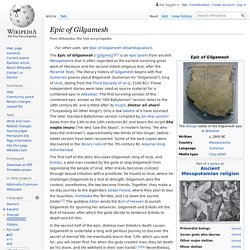
The literary history of Gilgamesh begins with five Sumerian poems about Bilgamesh (Sumerian for "Gilgamesh"), king of Uruk, dating from the Third Dynasty of Ur (c. 2100 BC). These independent stories were later used as source material for a combined epic in Akkadian. The first surviving version of this combined epic, known as the "Old Babylonian" version dates to the 18th century BC and is titled after its incipit, Shūtur eli sharrī ("Surpassing All Other Kings"). Only a few tablets of it have survived. Pāṇini - Wikipedia. Ancient Sanskrit grammarian Pāṇini (Sanskrit: पाणिनि) (pronounced [paːɳɪnɪ], variously dated between fl. 4th century BCE; and "6th to 5th century BCE"[web 1][note 1]) was an ancient Sanskrit philologist, grammarian, and a revered scholar in ancient India. The Kybalion Resource Page. Pyramid Texts - Wikipedia. Pyramid Text inscribed on the wall of a subterranean room in Teti's pyramid, at Saqqara.
Corpus Hermeticum - John Everard. The Alchemy web site on Levity.com.